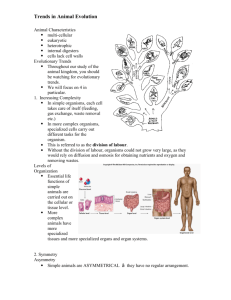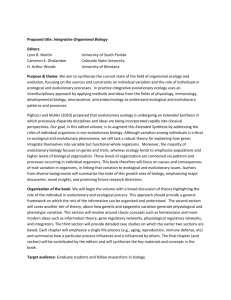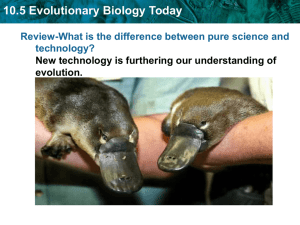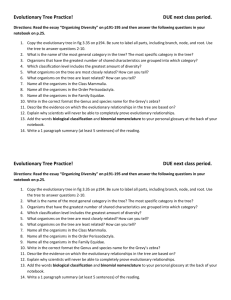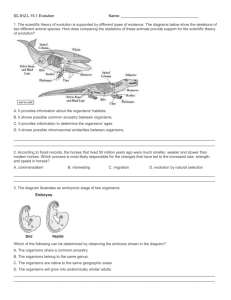AP BIOLOGY SUMMER ASSIGNMENT 2015 Welcome to the world
advertisement
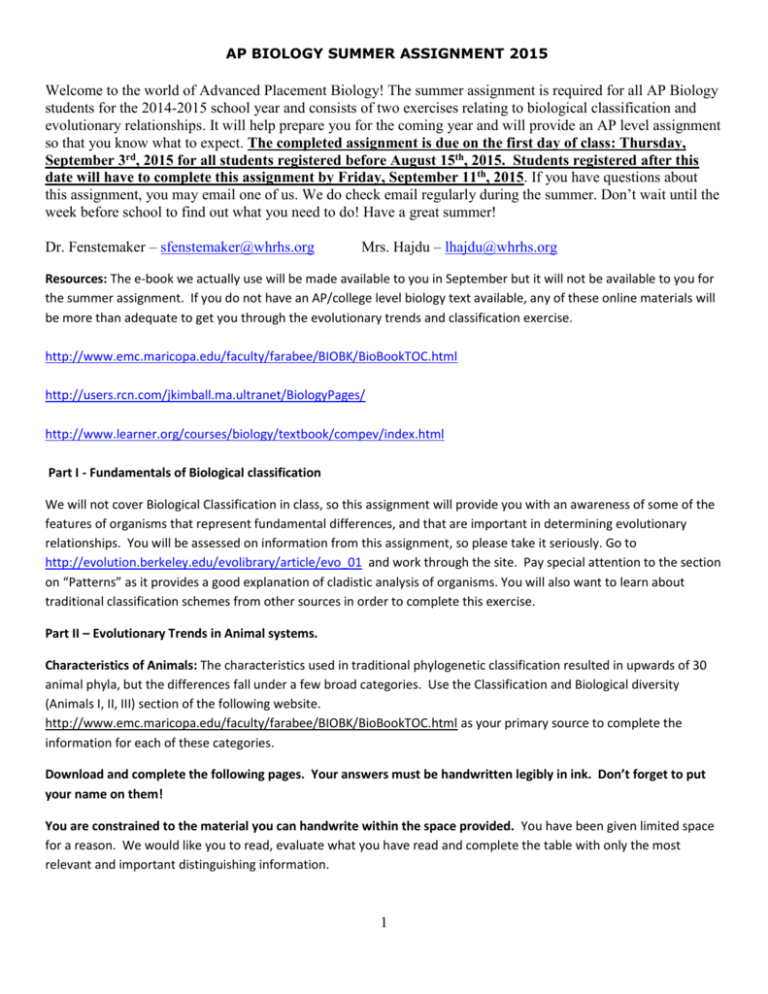
AP BIOLOGY SUMMER ASSIGNMENT 2015 Welcome to the world of Advanced Placement Biology! The summer assignment is required for all AP Biology students for the 2014-2015 school year and consists of two exercises relating to biological classification and evolutionary relationships. It will help prepare you for the coming year and will provide an AP level assignment so that you know what to expect. The completed assignment is due on the first day of class: Thursday, September 3rd, 2015 for all students registered before August 15th, 2015. Students registered after this date will have to complete this assignment by Friday, September 11th, 2015. If you have questions about this assignment, you may email one of us. We do check email regularly during the summer. Don’t wait until the week before school to find out what you need to do! Have a great summer! Dr. Fenstemaker – sfenstemaker@whrhs.org Mrs. Hajdu – lhajdu@whrhs.org Resources: The e-book we actually use will be made available to you in September but it will not be available to you for the summer assignment. If you do not have an AP/college level biology text available, any of these online materials will be more than adequate to get you through the evolutionary trends and classification exercise. http://www.emc.maricopa.edu/faculty/farabee/BIOBK/BioBookTOC.html http://users.rcn.com/jkimball.ma.ultranet/BiologyPages/ http://www.learner.org/courses/biology/textbook/compev/index.html Part I - Fundamentals of Biological classification We will not cover Biological Classification in class, so this assignment will provide you with an awareness of some of the features of organisms that represent fundamental differences, and that are important in determining evolutionary relationships. You will be assessed on information from this assignment, so please take it seriously. Go to http://evolution.berkeley.edu/evolibrary/article/evo_01 and work through the site. Pay special attention to the section on “Patterns” as it provides a good explanation of cladistic analysis of organisms. You will also want to learn about traditional classification schemes from other sources in order to complete this exercise. Part II – Evolutionary Trends in Animal systems. Characteristics of Animals: The characteristics used in traditional phylogenetic classification resulted in upwards of 30 animal phyla, but the differences fall under a few broad categories. Use the Classification and Biological diversity (Animals I, II, III) section of the following website. http://www.emc.maricopa.edu/faculty/farabee/BIOBK/BioBookTOC.html as your primary source to complete the information for each of these categories. Download and complete the following pages. Your answers must be handwritten legibly in ink. Don’t forget to put your name on them! You are constrained to the material you can handwrite within the space provided. You have been given limited space for a reason. We would like you to read, evaluate what you have read and complete the table with only the most relevant and important distinguishing information. 1 Typed charts or “extra sheets” of information will not be accepted. This is not meant to be an information dump of everything you can find on the internet. Keep in mind that not only is this assignment due on the first day of school, you will be formally assessed on the information from this assignment within the first week of school. For each of the characteristics below, summarize the evolutionary development of the characteristic using the terms as a guide. Do not simply define the term. Do not simply “take notes” on each term. Think about the term as part of a trend in evolution and note key developmental features and their significance. For example, increased complexity often yields increased ability or efficiency. Make sure these are addressed. DO NOT HAND IN THESE INSTRUCTION PAGES. 2 Part I - Fundamentals of Biological classification 1. What criteria are used in classifying organisms? 2. Compare cladistics with traditional and molecular systematics. 3. What is a cladogram? How does it differ from a traditional phylogenetic tree? Which is right? 4. The organisms traditionally assigned to the kingdom monera are now divided into two kingdoms. What are these kingdoms and why is this an important distinction? What does it imply about the evolutionary relatedness of the three domains of life? 5. We say that the animal kingdom is monophyletic. What does this mean? Give a few pieces of evidence that support this assertion? 3 6. What physical or biochemical characteristics must have been present in the last common ancestor of all organisms? Provide a minimum of three different characteristics. ---End--- 4 Part II – Evolutionary Trends in Animal systems. Development of the Digestive system Feature - What is it? Who has it? Overall purpose in all organisms: - Intracellular digestion - Extra cellular digestion o Gastrovascular cavity o Alimentary canal Significance – WHY IS IT IMPORTANT? 5 Development of Circulation/Transport Feature - What is it? Who has it? Overall purpose in all organisms: - Simple diffusion (single celled organisms) - Gastrovascular cavity - Open circulatory systems - Closed circulatory system o Gills o Lungs Significance – WHY IS IT IMPORTANT? 6 Development of the Nervous system Feature - What is it? Who has it? Overall purpose in all organisms: - Nerve net - Ganglia and nerves - Cephalization Significance – WHY IS IT IMPORTANT? 7 Body symmetry Feature - What is it, who does it? Body Symmetry Significance – WHY IS IT IMPORTANT? Asymmetry Radial Symmetry Bilateral symmetry Now consider the characteristics you have just described and above and the cladogram on the next page. Add the characteristics into the diagram to show the point at which they developed in relation to the phyla. You may have multiple features as derived traits; just list each separately. 8 9

